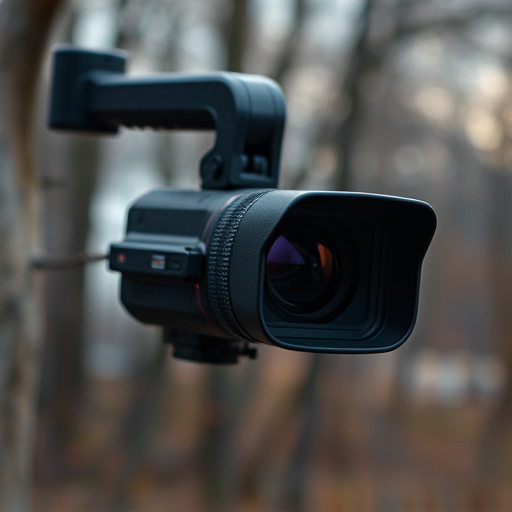Covert recording with Wireless Night Vision Security Cameras Indoors strategically places cameras to capture sensitive information undetected, balancing discretion and visibility. Leveraging advanced infrared tech, motion detection, and understanding environmental factors, these cameras provide clear footage while minimizing detection risk. Ideal for high-traffic areas like lobbies and offices, they offer 24/7 surveillance, remote access, and discreet monitoring, enhancing security without compromising privacy—crucial for internal investigations and deterring unauthorized access, but adhering to strict legal considerations regarding placement and consent.
Uncover the art of covert recording spot identification with our comprehensive guide. Explore the benefits of integrating Wireless Night Vision Security Cameras Indoors for enhanced indoor security. Learn subtle placement techniques ensuring optimal coverage and discover common areas ripe for discreet surveillance within buildings. Additionally, navigate ethical considerations and understand the legal framework governing the strategic use of hidden cameras indoors.
- Understanding Covert Recording Spot Identification
- Advantages of Wireless Night Vision Security Cameras Indoors
- Discreet Placement Techniques for Optimal Coverage
- Common Areas for Covert Surveillance Inside Buildings
- Ethical Considerations and Legal Framework for Indoor Hidden Camera Use
Understanding Covert Recording Spot Identification
Covert recording spot identification involves strategically placing wireless night vision security cameras indoors to capture sensitive information undetected. It’s a delicate process that requires understanding environmental factors, like lighting and angles, as well as legal considerations related to privacy. By leveraging advanced infrared technology and motion detection features typical of indoor wireless night vision security cameras, professionals can identify optimal recording spots that minimize the risk of detection while maximizing clear, usable footage.
Proper spot identification ensures that these hidden cameras capture crucial details without compromising privacy or inviting legal repercussions. It demands a balance between discretion and visibility, factoring in potential obstacles like furniture placement, room layouts, and even the behavior patterns of those within the space to be monitored. With the right approach, wireless night vision security cameras can provide invaluable insights while remaining virtually invisible.
Advantages of Wireless Night Vision Security Cameras Indoors
Wireless Night Vision Security Cameras Indoors offer a discreet and advanced surveillance solution for homes and businesses. One of the key advantages is their ability to provide clear, detailed footage even in complete darkness, thanks to built-in infrared technology that enhances visibility. This feature is particularly beneficial for indoor spaces where natural light may be limited, ensuring round-the-clock monitoring without compromising on quality.
Additionally, these cameras eliminate the need for messy and potentially obtrusive cables, making installation quick and easy. Wireless connectivity allows for remote access to live feeds and recorded footage, providing peace of mind and increased flexibility. This is ideal for homeowners or business owners who want to monitor their premises from anywhere, at any time, without the hassle of physical connections.
Discreet Placement Techniques for Optimal Coverage
In the realm of covert recording, discreet placement is key to achieving optimal coverage without raising suspicion. When it comes to indoor spaces, Wireless Night Vision Security Cameras offer a subtle yet powerful solution. These cameras can be strategically positioned in hard-to-see areas, such as corners, above doors, or behind furniture, taking advantage of their wireless capabilities for easy installation and minimal visual impact. This technique ensures that every angle is captured without compromising on quality, providing comprehensive surveillance.
To maximize effectiveness, consider the environment’s unique characteristics. For instance, in high-traffic areas, cameras should be placed to capture clear views of entry points or common gathering spots. In quiet rooms like offices or libraries, a single well-placed camera can monitor multiple entries and exits, ensuring discrete yet comprehensive coverage. By combining these placement techniques with advanced Wireless Night Vision Security Cameras, you create an invisible network that discourages potential intruders while offering peace of mind.
Common Areas for Covert Surveillance Inside Buildings
In indoor settings, covert recording is often necessary for security and surveillance purposes, especially in sensitive areas where privacy needs to be maintained. Common locations for such covert operations include high-traffic corridors, like lobbies, reception areas, and hallways—places where suspicious activity might occur or vital information can be gathered. These areas benefit from the discreet placement of wireless night vision security cameras indoors, offering 24/7 surveillance without compromising aesthetics.
Another strategic spot could be offices or conference rooms for internal investigations or employee monitoring. Restrooms and changing facilities also demand covert attention to deter unauthorized access and protect personal privacy. Wireless technology ensures that these cameras can be set up and managed remotely, making them ideal for covert recording in buildings where discreteness is paramount.
Ethical Considerations and Legal Framework for Indoor Hidden Camera Use
The use of hidden cameras, particularly wireless night vision security cameras indoors, raises significant ethical and legal considerations. While these devices offer enhanced security, their covert nature can infringe upon privacy rights. It is crucial to understand the legal framework governing their deployment to ensure compliance with relevant regulations.
In many jurisdictions, the placement of surveillance equipment must adhere to strict guidelines. This includes obtaining consent from individuals who may be captured on camera and ensuring that the use of such devices is proportionate to the potential benefits. The misuse of wireless night vision security cameras indoors can lead to severe legal consequences, including civil rights violations and criminal charges. Therefore, it’s essential for users to balance their security needs with the ethical imperative of respecting personal privacy.
In conclusion, the art of covert recording spot identification is a delicate balance between security needs and privacy rights. While wireless night vision security cameras indoors offer significant advantages for enhanced surveillance, their discreet placement requires careful consideration to respect ethical boundaries and adhere to legal frameworks. By understanding the optimal placement techniques and common areas within buildings, professionals can ensure comprehensive coverage without compromising on privacy.
